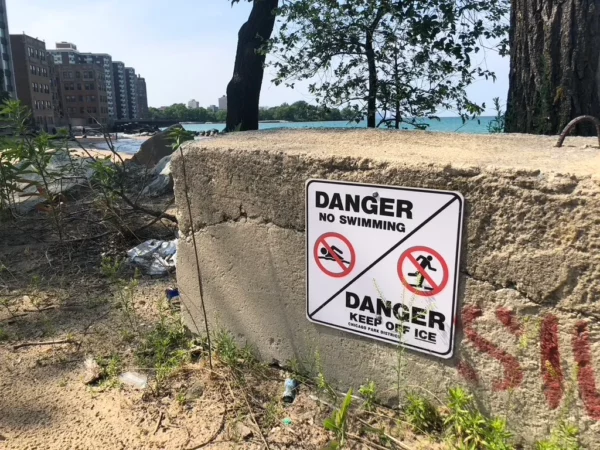
Editor’s Note: 2/15/22 This story has been updated: Cold Cover: Great Lakes ice forms after initial low percentage
The Great Lakes News Collaborative includes Bridge Michigan; Circle of Blue; Great Lakes Now at Detroit Public Television; and Michigan Radio, Michigan’s NPR News Leader; who work together to bring audiences news and information about the impact of climate change, pollution, and aging infrastructure on the Great Lakes and drinking water. This independent journalism is supported by the Charles Stewart Mott Foundation. Find all the work HERE.
The Great Lakes’ annual winter freeze is “off to a slow start,” with ice coverage “well below average for this time of year,” said James Kessler, a scientist at the National Oceanic and Atmospheric Administration’s Great Lakes Environmental Research Laboratory.
The laboratory’s most recent projection showed that only 12.3% of the lakes’ surfaces are likely to freeze before spring. Although annual maximum ice coverage is highly variable from year to year, this year’s forecast predicts unusually scant amounts of ice.
It’s “typical to have ice cover as high as 75% or as low as 25% percent for that annual maximum value,” said Kessler. NOAA’s data since 1973 show a long-term average of a 50% frozen lake surface area during the annual maximum ice cover.
Lake Michigan and Lake Huron are both likely to see less ice than ever at peak freeze in 2022. “Michigan and Huron were both projected to be lower than they’ve been as far as the maximum ice cover for the year, about 10 and 12%, respectively, where the lowest on record was about 13 and 23%, respectively.”
Unusually low ice coverage affects Great Lakes ecosystems and regional weather. In the lakes themselves, Kessler said, “certain microorganisms and fish species, actually they require ice cover for their spawning cycles, so when there’s not ice, these species are hurting.” On land, the region might see more lake-effect snow in a low ice coverage year.
Kessler also noted that “from a human perspective, there’s certainly a lot of recreation and tourism that is related to going out on the lakes. You know, people that go ice fishing and snowmobiling and cross-country skiing.” Less ice coverage and thinner ice can disrupt these activities and local economies that rely on them.
Inconsistent ice conditions and highly variable ice forecasts themselves can make recreation hazardous. “When ice cover is so hard to predict and when we have these huge variations from one year to the next, it’s very difficult for people to know where and when ice is safe.”
Kessler stressed that because it’s still early in the season, this year’s projections could change if the Great Lakes see unusually cold temperatures over the next two months. Annual maximum ice cover usually arrives in mid to late February, and sometimes in early March. “The lakes are so massive, they have so much heat content that the air really needs to be cold for a long period of time until the lakes really start to cool enough in order to freeze,” he said.
Regardless, this won’t be the last year we’re likely to see lower ice coverage than in the past. “There is a negative trend, and it’s statistically significant for all the lakes, except for Lake Huron, which just falls a little bit on the non-statistically significant side,” Kessler said. “Basin-wide for all five lakes, the maximum ice cover percentage is decreasing about 5% per decade.”
Learn more by listening to Stateside’s interview with scientist James Kessler above, or by visiting NOAA GLERL’s website on Great Lakes ice cover.
Catch more news on Great Lakes Now:
Breeze Boost: What’s the connection between breezy Lake Michigan days and high ozone levels?
Bugs, Shorter Winters, Climate: Great Lakes vineyards face changing circumstances
Featured image: A MODIS satellite image shows significant late season ice cover on Lake Superior, March 16, 2014. (Photo Credit: NOAA Great Lakes CoastWatch)
8 Comments
-
Wrong! Already at 30% on January 28.
-
Now 39% ice cover – and rising fast. Reaching 50% or more looks like a near certainty. When was this interview conducted?
-
-
It’s amazing how wrong the author of this article turned out to be. As of February
Michigan and Huron are 25 and 27 percent. Continued cold over the next week or two will increase ice coverage.The author must receive grants to promote fear of climate change. Oh did I mention there are more Polar Bears now then AL Gores predictions were made and New York is not under water.
-
More fear porn! Researchers who predicted 12.3% ice coverage should resign their propaganda jobs and look for something more attuned to their cognitive capacities. Fast food restaurants always need help.
-
colder temps coming too.
Everyone knows weather predictions are not trustworthy, no biggie. But decades of fearmongering without accountability? Expect the same predictions next year, or likely more dire. People already believe there no ice in the Arctic, convincing of that in the Great Lakes is like taking beef from a vegan. When the ice trend is steady or upward over a 40 year period in 4.5 billion years somehow it can still be blamed on man-made climate change. We are living in a time when people believe 2 + 2 = 5 willingly.
-
2/25 they are above yearly average at at 54%
-
56% liars 2/26
-
I’m from the future. The dire predictions of record low ice coverage was mis informed. All lakes spent some time above average and are holding ice longer than average. Try to spin catastrophe again next year? All’s well.




